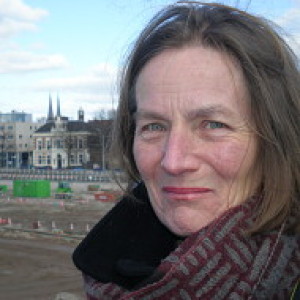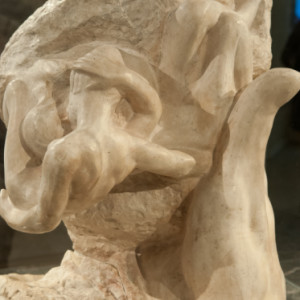Creator's Hand
Travelled together with my 2 eldest some 600 kms today (up & down) to see the exhibition of Rodin's works at the Groninger Museum and we fell in awe again for this master's works!
The initial piece on show is this hand named 'The Creator's Hand' and the idea to mold man and woman, Adam and Eve out from clay Rodin realised movingly; see the extra for the other side of this piece.
On internet I found the review of Sandra Smets what I worked upon with Google translate and perhaps you like to read:
" Rodin - Genius at Work. until April 30th at the Groninger Museum.
All of this, people and Creator, is surrounded by the raw material they are made of by their Creator: Auguste Rodin (1840-1917). This plaster sculpture is at the entrance of the exhibition on the French sculptor in the Groninger Museum. A significant starting point for this exhibition that is about craft, create, model, material. The studio is surrounded by pictures of a proud man with beard between the torsos and human images that would make him patriarch of modern sculpture.
That was not very obvious initially. After a poor childhood at fifteen Rodin entered a drawing course, then gave little foothold. With his penchant for realism, he would stop the flow - the classic leather. But in 1880 he received a first contract for the Gate of Hell, that tide brought him fame, and finally led to his studio where he managed some fifty folks. The models who walked around, he sometimes called with a " ho, stop 'stop", thus to quickly capture their nonchalant poses. Those natural movements, arched necks, back muscles, lead to a very physical exposure full of expression. Rodin did things differently, his works show a different order, as for the Balzac portraits what are shown in this exhibition in a special hall. Rodin wanted to portray this nude obese writer Balzac and saw the author’s sizeable belly as a metaphor for his creative power, others looked differently upon the sculpts then and a scandal was born.
Rodin's realism was different from the polished classicism of yesteryear, and always expresses a great sense of liveliness. His sculpts of women crying with grief, or the damned suffering from a deep sense of despair; they come alive in his sculpts. His images of hands, are remarkable and the set named The Cathedral and designed in 1908, consist of two bronze hands forming a gothic arch, the fingers almost touch each other, making one suspect a spiritual space between them. A gesture of creation, but cast in bronze only in 1962 - which is divine, as Rodin continues to create after his death!
But seriously: many late Rodin casts are a discussion point. The hand of the master, where this exhibition is so explicit about, which you can see in the images he has never seen himself?
currency devaluation
Rodin had foresight, and settled his legacy himself. His work is managed by the Musée Rodin which was given the right to be bronze, up to twelve, and to pour anew and sell off. At the press conference the Parisian curator was still making advertisement for the museum and just sold another Hells Gate to Mexico with which the museum secured its finance another four years. It is good news for new overseas museums, but in old Europe the museums with old bronze see this new reproduction of Rodin’s works sometimes as a kind of currency devaluation.
That itch, the exhibition smart solution: it shows mainly plaster, unique. This exhibition that travels through the US and Canada, organized by the Musée Rodin (where 90 percent of the loans comes from) and the Musée des Beaux-Arts in Montreal. Groningen is the only European destination. And no, Rodin has never once drank tea in Groningen, but also without historical connection was this vermoedeljke blockbuster welcome, billed as Rodin's largest exhibition ever in the Netherlands. The minimal additions of the Groninger Museum are gracefully done with humor: it filled a room with five matte and glossy casts of The Bronze Age: five different castings, patinas, years. Want to get up real Rodin?
Atelier Feeling is central to the workshop feeling, tables with plaster body parts like Rodin puts new images together, hands and bodies and torsos as unthinkable creations from hell. Yet you never think "well well well it could do with less," and that is an achievement, because our ideas of pathos are different than common a hundred years ago - just look at old movies. Not with Rodin; he creates a new reality. Through its focus on naked bodies, natural movements, the exhibition looks like a choreography of bodies. Modern dance.
Meanwhile, some classics are not lacking. Such as The Thinker (gypsum), one and all muscle bonk which nevertheless radiates an entirely mental effort. Kiss stands as small bronze (sales, Musee Rodin reported in several dimensions). The picture emerged despite its sweetness from the Gate of Hell. Over the years, Rodin would develop more of those damned to independent sculptures, as Paolo and Francesca da Rimini from Dante's Divine Comedy. As punishment for their adultery, they were riveted together for eternity in an embrace. But here, no hell, the punishment will love again.
In which love proves particularly the corner with sculptures in marble magnificent. The glistening white material with its soft contours gives a wonderful sensibility to this naked, sensual dead Adonis and vulnerable Eva ashamed discovered her nakedness. Layered eroticism in his marble Pan and Nymph (1910) is a masterful move: he just turns up her except with lust even with affection, they throw themselves wholeheartedly to the back but wants to be with him - there is so much to read his images. It is undisputed Rodin, unica, but one salient detail: Rodin’s hand of the creator is everywhere ~ It's a huge hand, with soft contours and powerful male fingers. Confident they bend around two small human figures that embrace each other so closely that they are completely absorbed in the other. They lie in the hands of God - who else has such great hands
Meanwhile, some classics are not lacking. Such as The Thinker (gypsum), one and all muscle bonk which nevertheless radiates an entirely mental effort. Kiss stands as small bronze (sales, Musee Rodin reported in several dimensions). The picture emerged despite its sweetness from the Gate of Hell. Over the years, Rodin would develop more of those damned to independent sculptures, as Paolo and Francesca da Rimini from Dante's Divine Comedy. As punishment for their adultery, they were riveted together for eternity in an embrace. But here, no hell, the punishment will love again.
In which love proves particularly the corner with sculptures in marble magnificent. The glistening white material with its soft contours gives a wonderful sensibility to this naked, sensual dead Adonis and vulnerable Eva ashamed discovered her nakedness. Layered eroticism in his marble Pan and Nymph (1910) is a masterful move: he just turns up her except with lust even with affection, they throw themselves wholeheartedly to the back but wants to be with him - there is so much to read his images. It is undisputed Rodin, unica, but one salient detail: Rodin’s hand of the creator is everywhere ~ It's a huge hand, with soft contours and powerful male fingers. Confident they bend around two small human figures that embrace each other so closely that they are completely absorbed in the other. They lie in the hands of God - who else has such great hands "


Comments
Sign in or get an account to comment.


